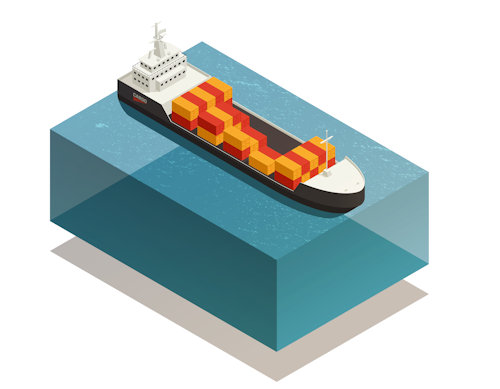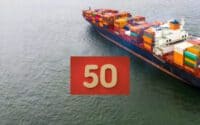The Future of Cargo Stowage: Automation and AI Revolutionizing the Maritime Industry

In an age of rapid technological advancement, the maritime industry finds itself at the crossroads of transformation. As ships traverse global waters, the intricate dance of cargo stowage and handling becomes pivotal not just for economic efficiency, but also environmental sustainability. Dive into this exploration of how optimized cargo stowage can revolutionize the shipping world, the promising role of AI and automation in enhancing operations, and the challenges that lie ahead in this brave new maritime world.
* Please send feedback/suggestions to editor @ shipuniverse.com
Historical Challenges in Cargo Stowage
1. Manual Planning:
In the early days of shipping, stowage planning was done manually. This involved a labor-intensive process of physically measuring cargo, then deciding the best place for it on the ship based on its size, weight, and destination. Mistakes or miscalculations often led to inefficient use of space or, worse, jeopardized the ship’s stability.
2. Lack of Standardization:
Before the introduction of standardized containers (like the TEU – Twenty-foot Equivalent Unit), cargo came in various sizes and shapes. This made the stowage process a complex puzzle, as each piece of cargo had to be treated uniquely.
3. Limited Technology:
Early cargo ships lacked the advanced tools and machinery to load and unload heavy cargo, extending the time ships spent in ports and increasing operational costs.
Addressing the Challenges:
The introduction of standardized containers in the 1960s revolutionized the maritime industry. Containers could be uniformly stacked, vastly simplifying and speeding up the stowage process. Additionally, technological advancements in cranes and other cargo-handling machinery further streamlined loading and unloading operations.
AI in the Maritime Industry: A New Wave of Optimization
1. What is AI?
Artificial Intelligence (AI) can be described as the simulation of human intelligence processes by machines. In the context of maritime operations, this involves algorithms, machine learning, and smart systems designed to mimic and often improve upon human decision-making capabilities.
2. Real-time Stowage Planning:
With AI, stowage planning is no longer a static process. AI algorithms can continuously analyze real-time data such as cargo weight, ship balance, weather conditions, and port schedules to adjust and optimize the stowage plan even during a voyage.
3. Predictive Maintenance:
AI systems can predict when parts of the ship or equipment are likely to fail by analyzing historical data and real-time conditions. This allows for proactive maintenance, reducing unplanned downtime.
4. Automated Ports:
The future may see ports where AI-driven robots load and unload cargo, guided by systems that can instantly calculate the most efficient stowage configuration. These systems would work in tandem with the ship’s own AI to ensure optimal loading and unloading sequences, reducing port turnaround times.
5. Safety and Compliance:
By analyzing vast amounts of data, AI can identify potential safety issues in stowage plans, ensuring that the ship’s stability is never compromised. Additionally, with ever-evolving maritime regulations, AI can ensure compliance by adjusting stowage plans in line with the latest rules.
Real-time Optimization of Stowage Plans through Automated Systems
1. Dynamic Data Analysis:
Modern automated stowage planning systems utilize an array of sensors and data feeds to constantly monitor the ship’s conditions. These include factors like the ship’s draft, tilt (list), and trim. Any imbalance can be hazardous, and the system continuously assesses these parameters.
2. Cargo Recognition:
Using a combination of weight sensors, RFID tags, and possibly computer vision systems, the automated stowage planning software can recognize the type, weight, and size of incoming cargo. This ensures that heavy containers don’t end up on top of lighter ones, and temperature-sensitive cargo is stowed appropriately.
3. Real-time Adjustments:
As cargo is loaded or offloaded, or as conditions at sea change, the system can dynamically adjust the stowage plan. For instance, if bad weather is predicted on the route, the system may suggest a stowage pattern that lowers the center of gravity, enhancing stability.
4. Integration with Port Data Systems:
By interfacing with port databases, the stowage system can prepare for the next port of call, arranging cargo in a sequence that facilitates faster loading and unloading. For instance, cargo destined for the next port would be more accessible.
Robotics in Cargo Handling: The Path to Fully Automated Ports
1. Robotic Cranes:
Many modern ports have started deploying automated gantry cranes. These cranes, guided by computer systems and an array of sensors, can pick up, move, and set down containers with pinpoint accuracy, operating continuously with fewer errors and downtime.
2. Autonomous Guided Vehicles (AGVs):
Replacing traditional human-operated terminal tractors, AGVs transport containers between the quay and the storage yard. These vehicles follow predefined paths, using sensors and GPS to navigate, optimizing the flow of containers within the port.
3. Robotic Sorting and Stacking:
In the storage yards, robotic systems can be employed to stack containers, considering factors like the container’s destination, weight, and type. This ensures efficient use of space and quick retrieval when the container is ready to be loaded onto a ship or truck.
4. Smart Ports:
By integrating AI-driven analytics, ports can predict and plan for peaks in activity, dynamically allocate resources, and coordinate between various robotic systems to achieve unparalleled efficiency.
5. Challenges and Considerations:
While the potential is immense, fully automated ports face challenges. These include high initial investment costs, the need for standardized equipment and processes, and potential cybersecurity vulnerabilities. Furthermore, transitioning to robotic operations has implications for the workforce, requiring retraining and redeployment in new roles.
Economic and Environmental Implications of Optimized Cargo Stowage
1. Fuel Savings:
When cargo is stowed optimally, a vessel maintains its balance and minimizes drag. This means that the ship’s engines don’t have to work as hard to maintain a given speed. As a direct consequence, optimized stowage can lead to significant fuel savings over long voyages. Given that fuel constitutes one of the largest operational expenses for ships, even marginal savings can have a considerable economic impact.
2. Quicker Turnaround at Ports:
Efficiently stowed cargo, especially when coordinated with port systems, can be unloaded and reloaded faster. This reduces the time a ship spends docked at a port, leading to decreased port fees and faster delivery times. Over time, this can enhance a shipping company’s reputation for reliability and punctuality.
3. Reduced Carbon Emissions:
The environmental implications are twofold. First, fuel savings directly translate to reduced carbon emissions, helping the maritime industry move closer to its sustainability goals. Secondly, optimized cargo stowage can lead to fewer trips, as ships can carry cargo more efficiently. Fewer trips mean less fuel consumption and fewer emissions overall.
Challenges in Integrating AI and Automation in the Maritime Industry
1. High Initial Investment:
The introduction of AI and automation requires substantial financial investments. This includes the cost of new equipment, software, and potentially even the retrofitting of ships and infrastructure. For many shipping companies, especially smaller ones, this upfront cost can be a deterrent.
2. Workforce Impact:
Automation, while enhancing efficiency, often comes at the cost of traditional jobs. Roles that were previously manual might become obsolete, leading to concerns about job losses. This transition requires careful management, including retraining programs and creating new opportunities within the evolving industry landscape.
3. Cybersecurity Concerns:
AI-driven and automated systems rely heavily on digital infrastructure, which introduces the risk of cyber-attacks. Ensuring the cybersecurity of these systems becomes paramount, especially given the potential catastrophic consequences of compromised maritime operations.
4. Technological Reliability:
While AI systems are designed to enhance decision-making, they’re not infallible. A system malfunction or misinterpretation of data can lead to costly mistakes. Therefore, there’s an ongoing debate about the balance between human oversight and automated decision-making.
5. Regulatory and Compliance Issues:
As with any rapidly advancing technology, regulation often struggles to keep pace. Maritime bodies and international regulators need to establish standards and guidelines for AI and automation, ensuring safety and accountability. Shipping companies have to navigate this evolving regulatory landscape, ensuring they remain compliant.
Integrating AI and automation into the maritime industry offers a host of benefits but is not without challenges. By understanding both the advantages and potential pitfalls, stakeholders can make informed decisions that propel the industry into a new era of efficiency and sustainability.

Do you have a Maritime Product or Service that may be of interest to Shipowners? Tell us about it here!
Do you have feedback or insights? Please reach out to editor @ shipuniverse.com



